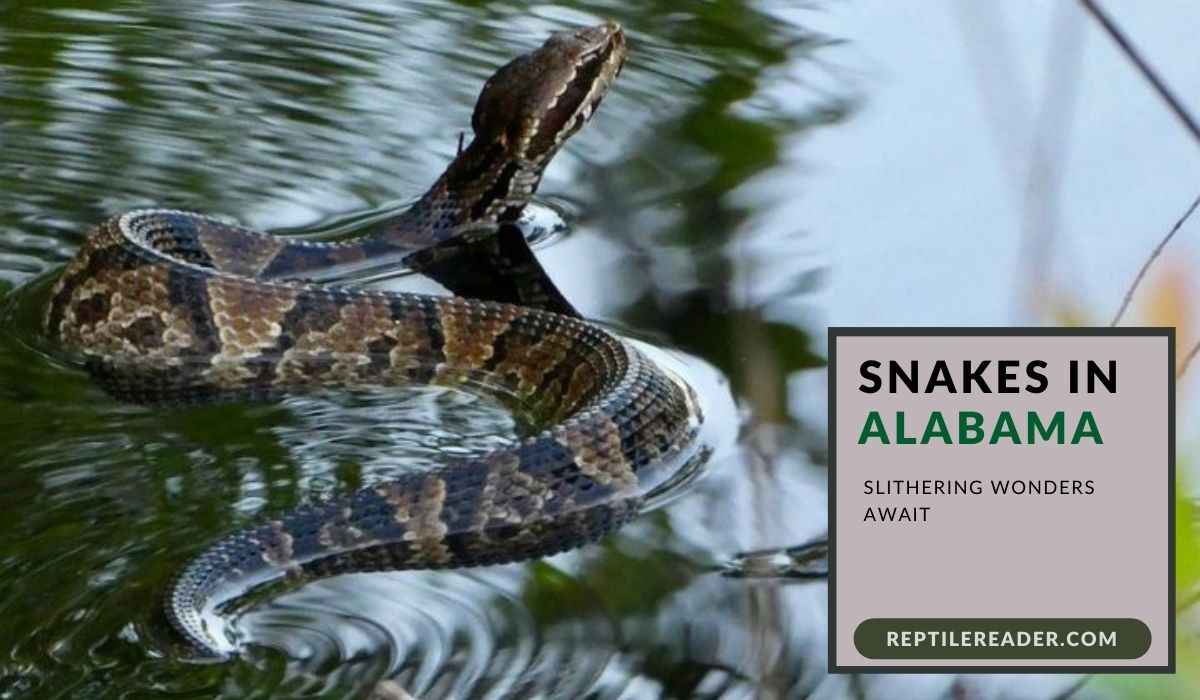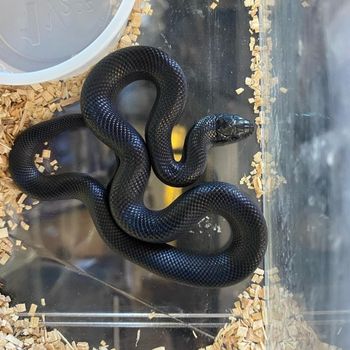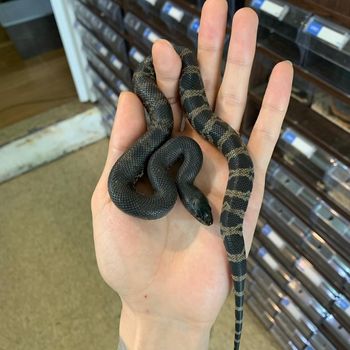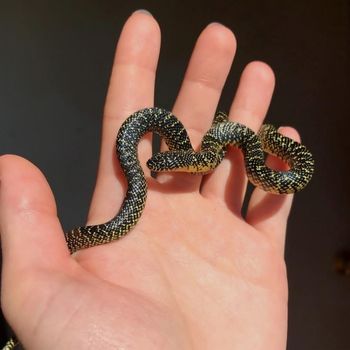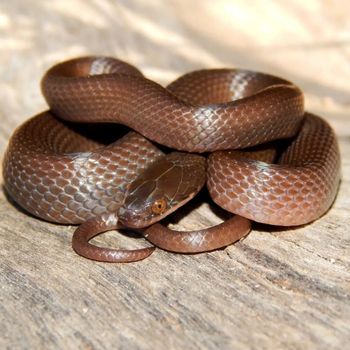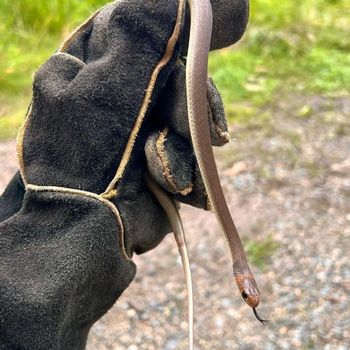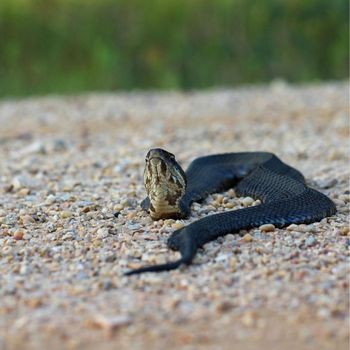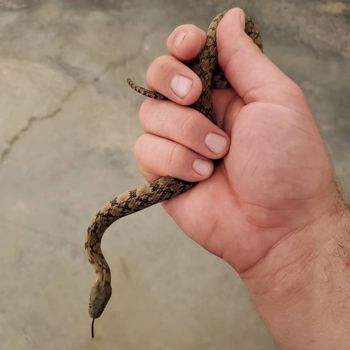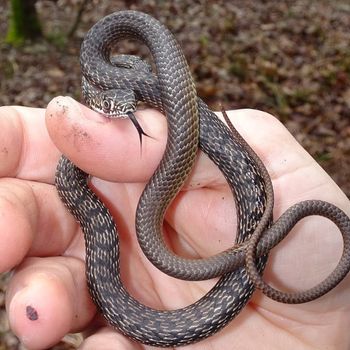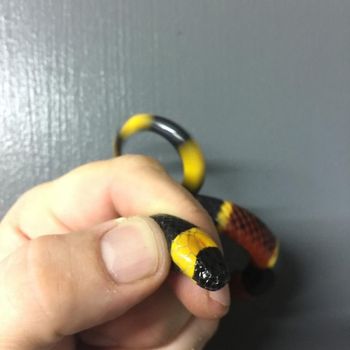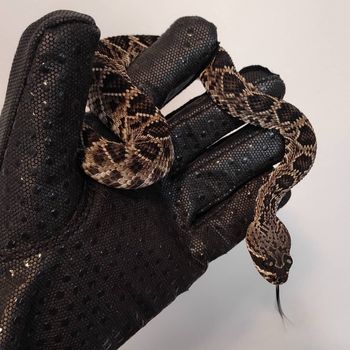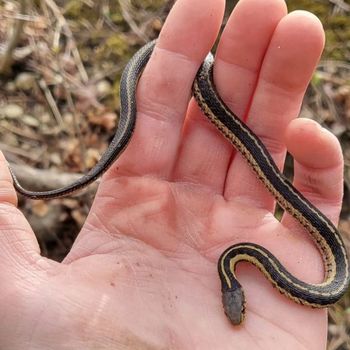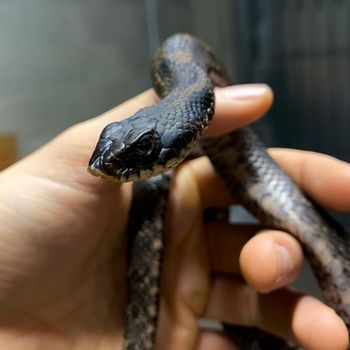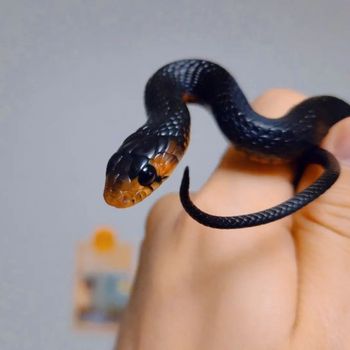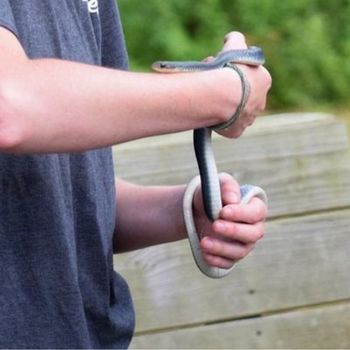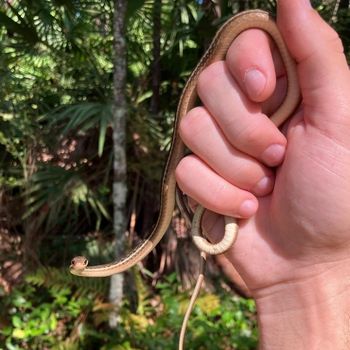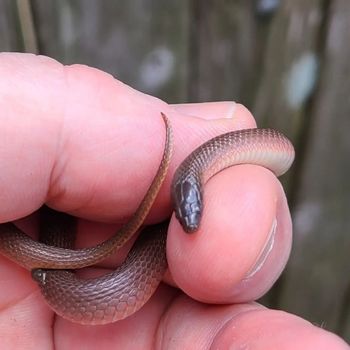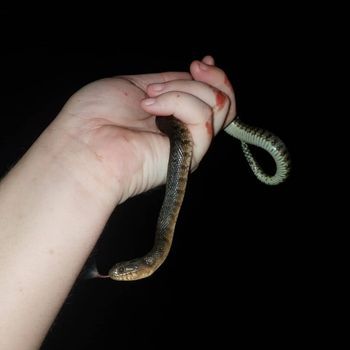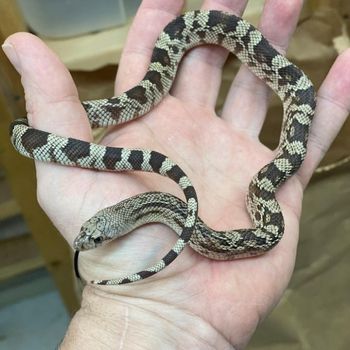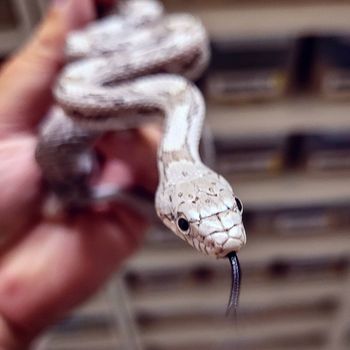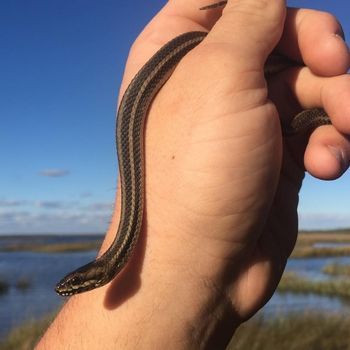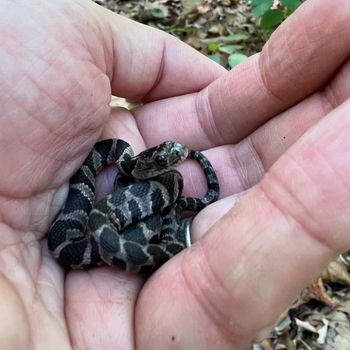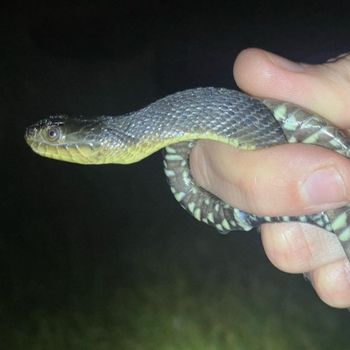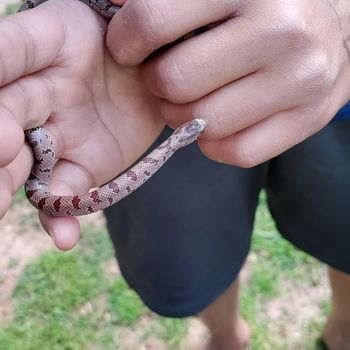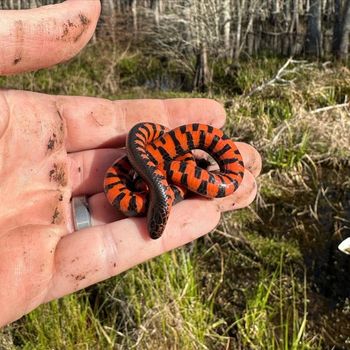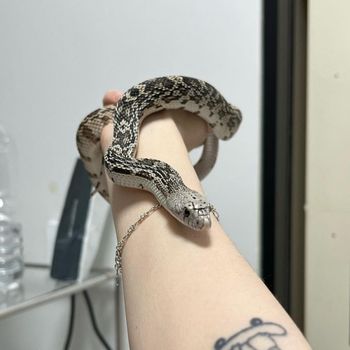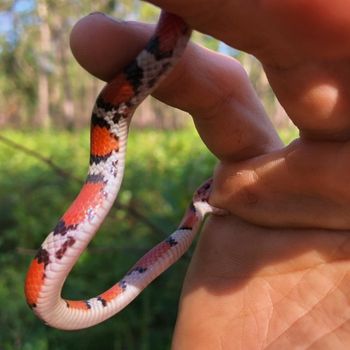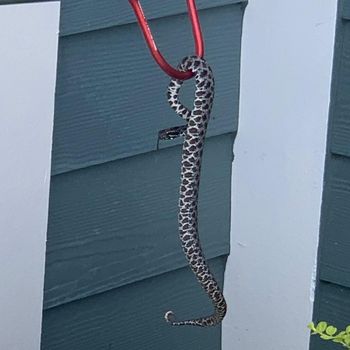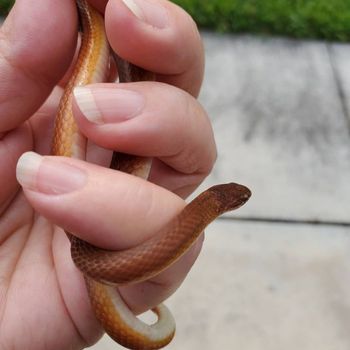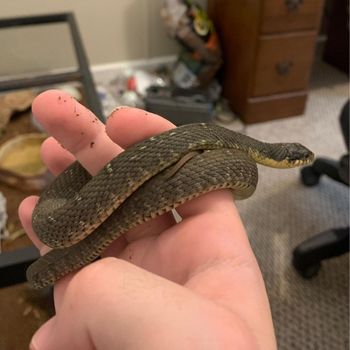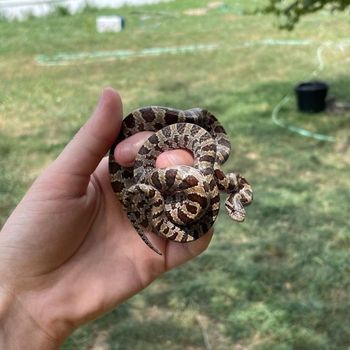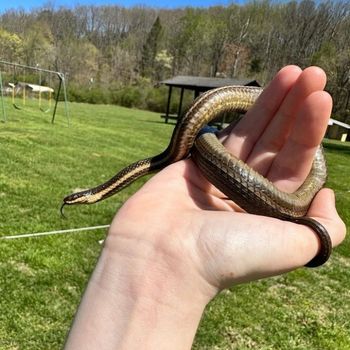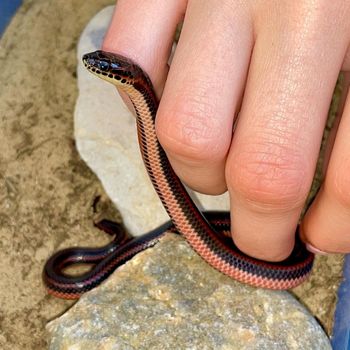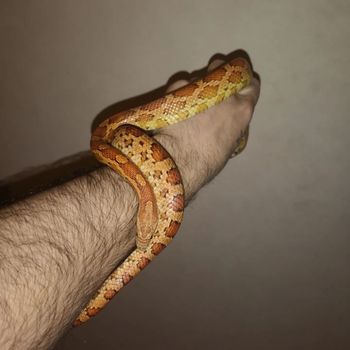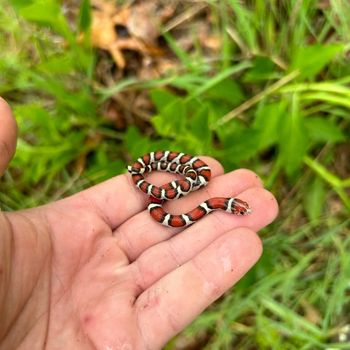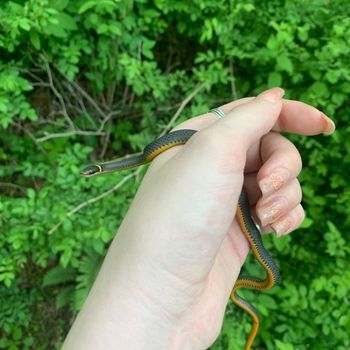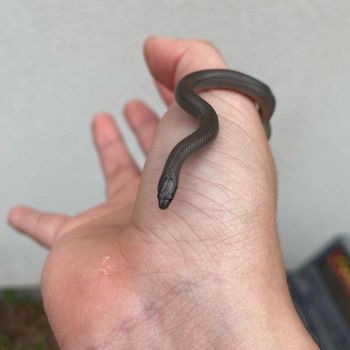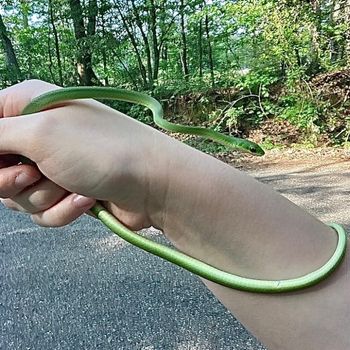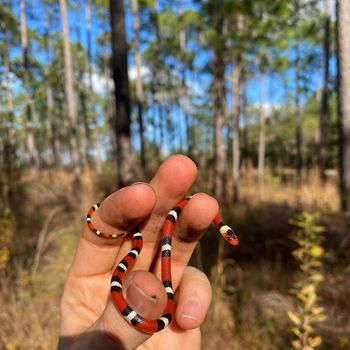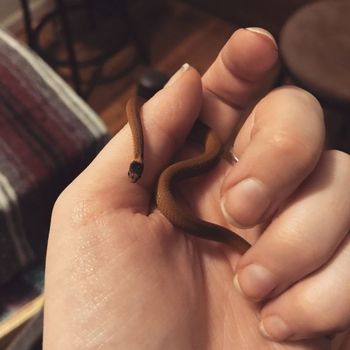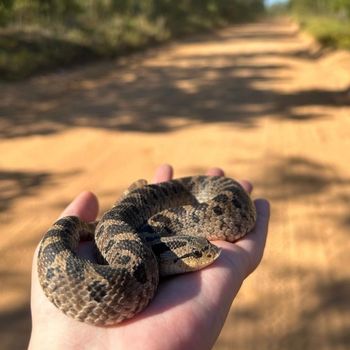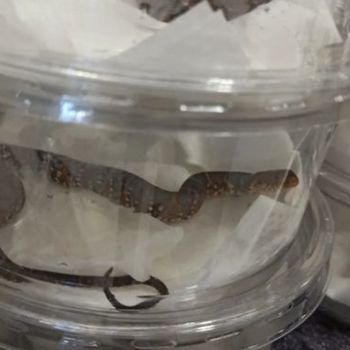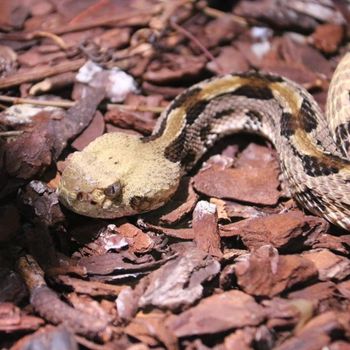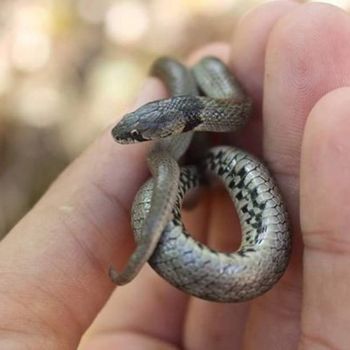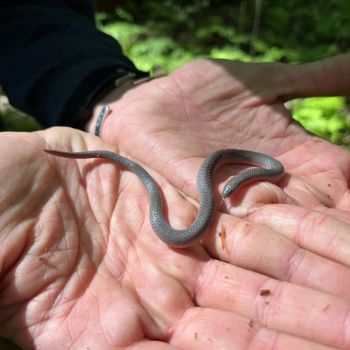Snakes in Alabama: Slithering Wonders Await
Hey there, snake enthusiasts and curious minds alike! Are you ready to embark on an adventure to uncover the amazing world of snakes right in the heart of Alabama?
You’re in for a treat, as we’re about to unveil the fascinating diversity of these slithering creatures that call this beautiful state their home.
From the well-known venomous rattlers to the lesser-known, non-venomous beauties, we’ve got all 50 of them covered. So, buckle up and join us as we dive into the intriguing world of Alabama’s snakes and learn about their unique traits, habitats, and the roles they play in our ecosystem. Let’s get started!
| # | Name | Details | Image |
| 1 | Black Kingsnake (Lampropeltis nigra) |
| 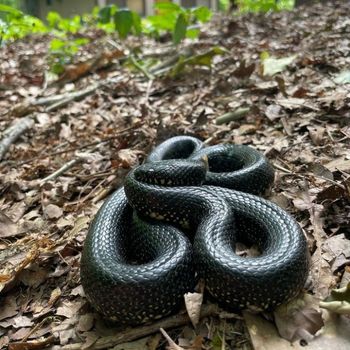 |
| 2 | Black Pine Snake (Pituophis melanoleucus lodingi) |
| 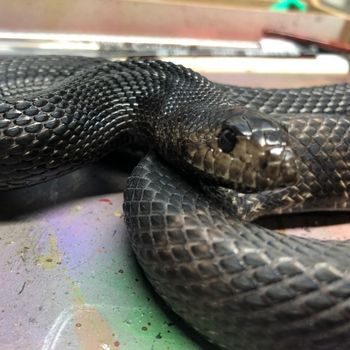 |
| 3 | Black Speckled Kingsnake (Lampropeltis nigra) |
| 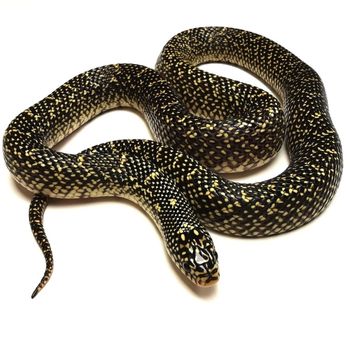 |
| 4 | Black Swamp Snake (Seminatrix pygaea) |
| 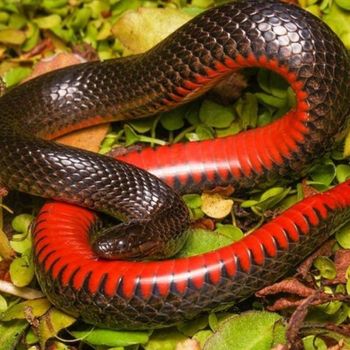 |
| 5 | Brown Water Snake (Lycodonomorphus rufulus) |
| 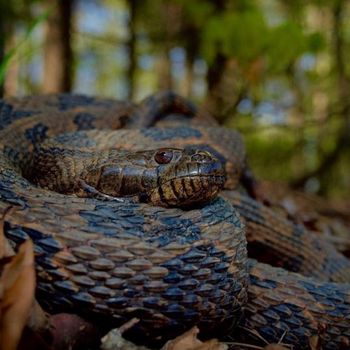 |
| 6 | Brownsnake (Pseudonaja textilis) |
| 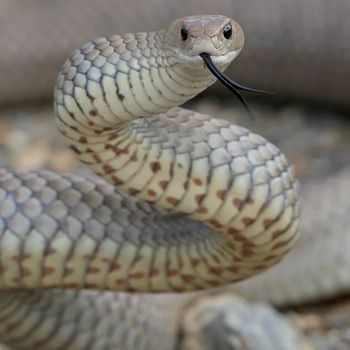 |
| 7 | Copperhead (Agkistrodon contortrix) |
| 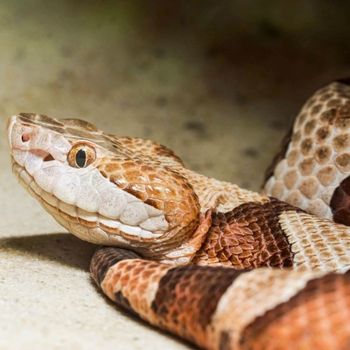 |
| 8 | Cottonmouth (Agkistrodon piscivorus) |
| 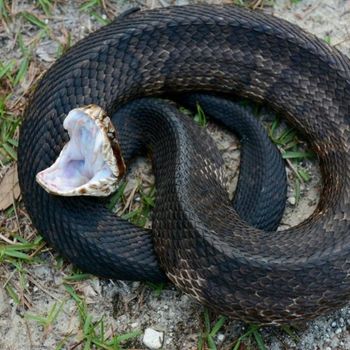 |
| 9 | Diamond-backed Water Snake (Nerodia rhombifer) |
| 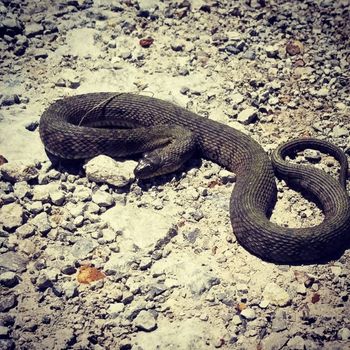 |
| 10 | Eastern coachwhip snake (Masticophis flagellum flagellum) |
|  |
| 11 | Eastern Coral Snake (Micrurus fulvius) |
| 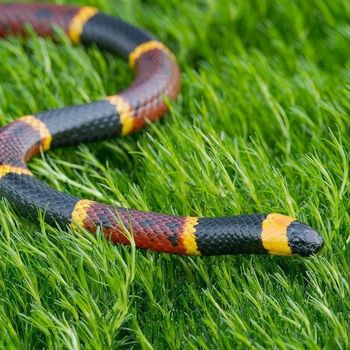 |
| 12 | Eastern Diamondback Rattlesnake (Crotalus adamanteus) |
| 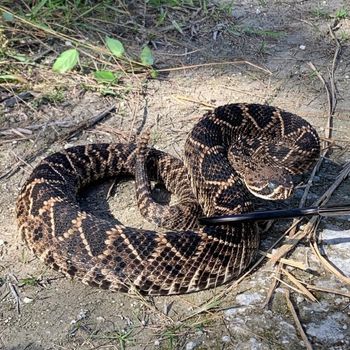 |
| 13 | Eastern Garter Snake (Thamnophis sirtalis sirtalis) |
| 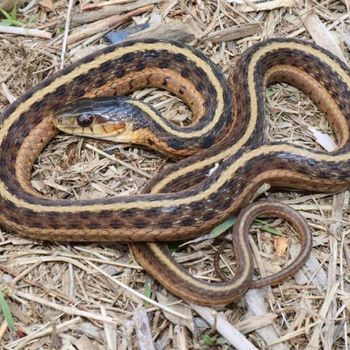 |
| 14 | Eastern Hog-nosed Snake (Heterodon platirhinos) |
| 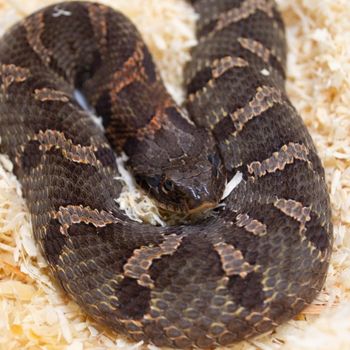 |
| 15 | Eastern Indigo Snake (Drymarchon couperi) |
| 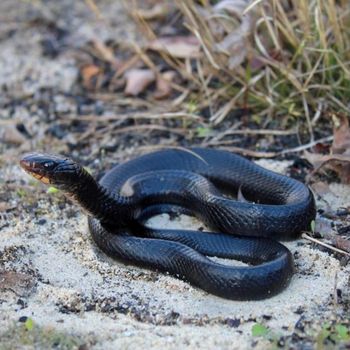 |
| 16 | Eastern Kingsnake (Lampropeltis getula) |
| 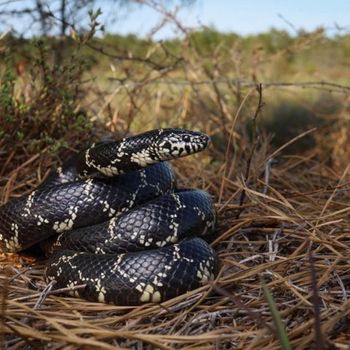 |
| 17 | Eastern Milksnake (Lampropeltis triangulum) |
|  |
| 18 | Eastern Racer (Coluber constrictor) |
| 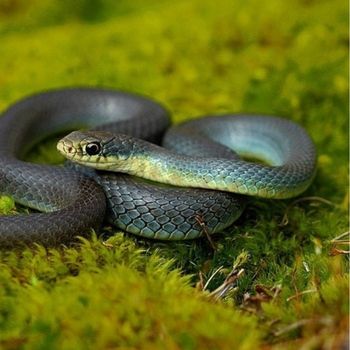 |
| 19 | Eastern Ribbon Snake (Thamnophis sauritus sauritus) |
|  |
| 20 | Eastern Smooth Snake (Coronella austriaca) |
|  |
| 21 | Florida Green Water Snake (Nerodia floridana) |
| 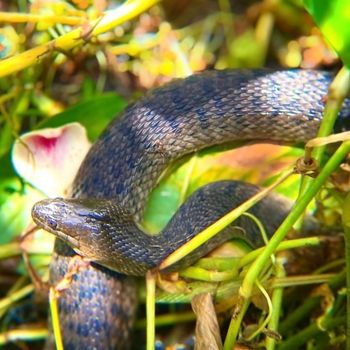 |
| 22 | Florida Pine Snake (Pituophis melanoleucus mugitus) |
| 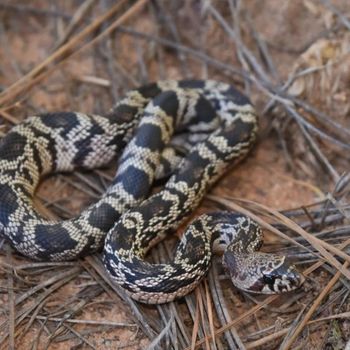 |
| 23 | Glossy Crayfish Snake (Regina rigida) |
| 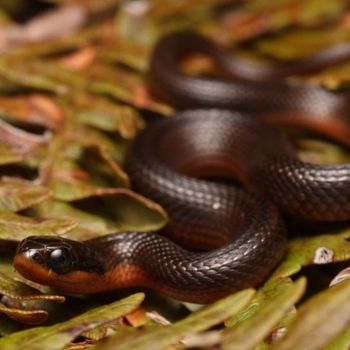 |
| 24 | Gray Rat Snake (Pantherophis spiloides) |
| 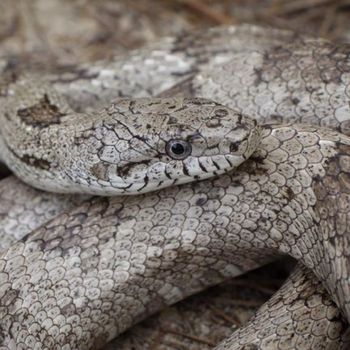 |
| 25 | Gulf Salt Marsh Snake (Nerodia clarkii clarkii) |
| 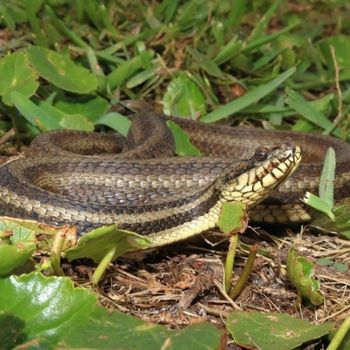 |
| 26 | Midland Water Snake (Nerodia sipedon pleuralis) |
| 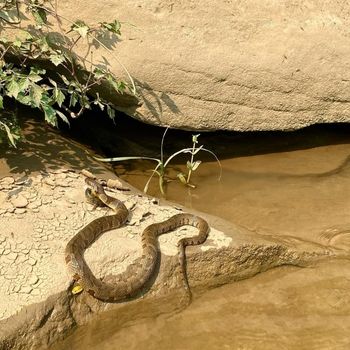 |
| 27 | Mississippi Green Water Snake (Nerodia cyclopion) |
|  |
| 28 | Mole Kingsnake (Lampropeltis calligaster rhombomaculata) |
| 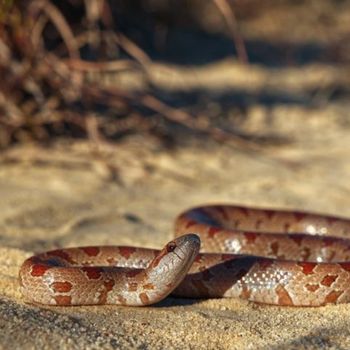 |
| 29 | Mud Snake (Farancia abacura) |
| 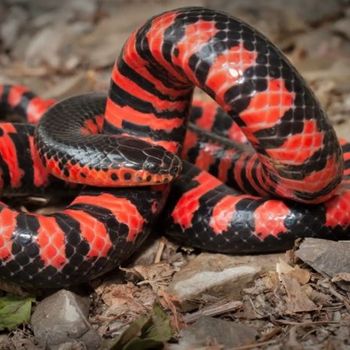 |
| 30 | Northern Pine Snake (Pituophis melanoleucus) |
| 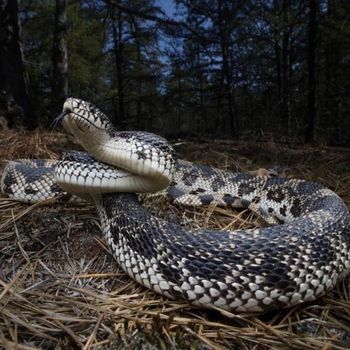 |
| 31 | Northern Red-bellied Snake (Storeria occipitomaculata occipitomaculata) |
|  |
| 32 | Northern Scarlet Snake (Cemophora coccinea copei) |
| 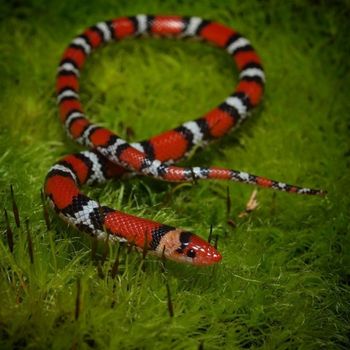 |
| 33 | Pigmy Rattlesnake (Sistrurus miliarius) |
| 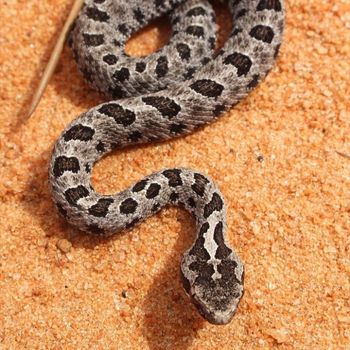 |
| 34 | Pine Woods Littersnake (Rhinechis scalaris) |
| 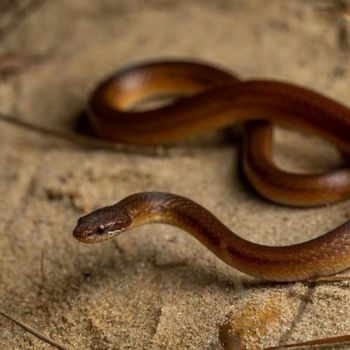 |
| 35 | Plain-bellied Watersnake (Nerodia erythrogaster) |
| 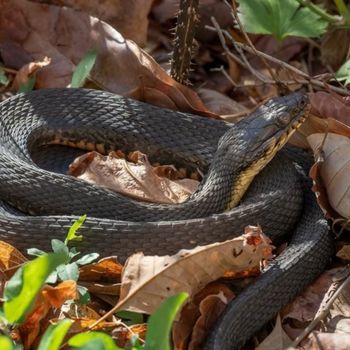 |
| 36 | Prairie Kingsnake (Lampropeltis calligaster) |
|  |
| 37 | Queen Snake (Regina septemvittata) |
| 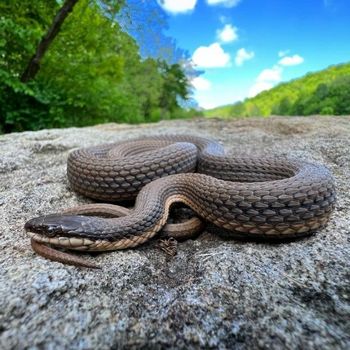 |
| 38 | Rainbow snake (Farancia erytrogramma) |
|  |
| 39 | Red Corn Snake (Pantherophis guttatus) |
| 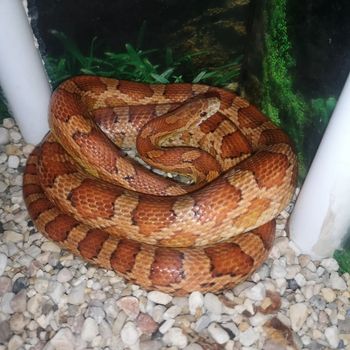 |
| 40 | Red Milksnake (Lampropeltis triangulum syspila) |
| 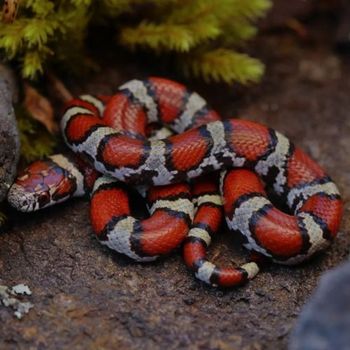 |
| 41 | Ringneck Snake (Diadophis punctatus) |
|  |
| 42 | Rough Earth Snake (Virginia striatula) |
|  |
| 43 | Rough Green Snake (Opheodrys aestivus) |
| 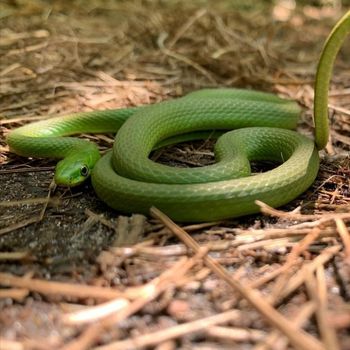 |
| 44 | Scarlet Kingsnake (Lampropeltis elapsoides) |
| 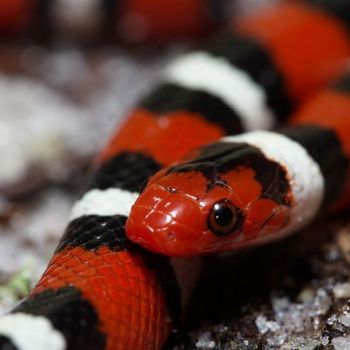 |
| 45 | Southeastern Crowned Snake (Tantilla coronata) |
| 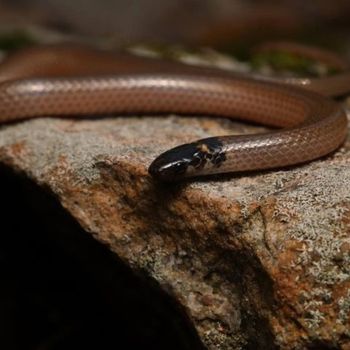 |
| 46 | Southern Hognose Snake (Heterodon simus) |
| 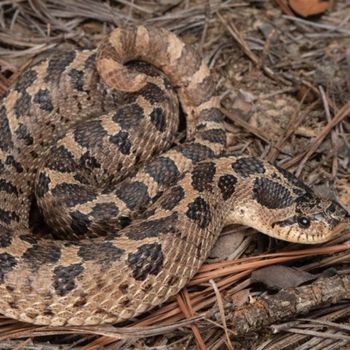 |
| 47 | Southern Watersnake (Nerodia fasciata) |
| 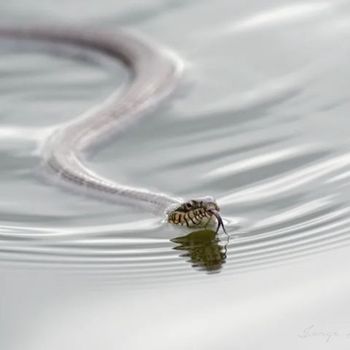 |
| 48 | Timber Rattlesnake (Crotalus horridus) |
|  |
| 49 | Western Smooth Snake (Coronella austriaca) |
| 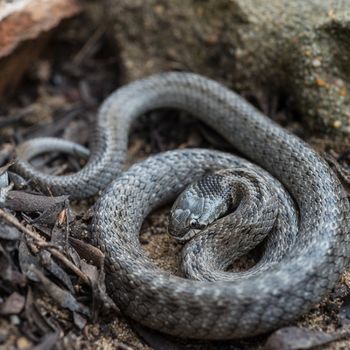 |
| 50 | Worm Snake (Leptotyphlops humilis) |
| 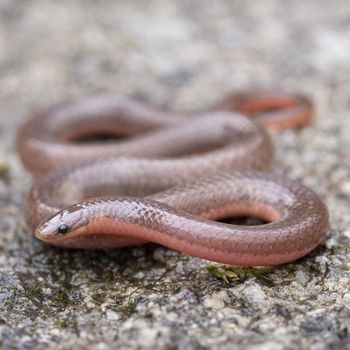 |
50 Snakes You Can Find in Alabama
In the state of Alabama, a fascinating array of serpents can be found slithering through its diverse landscapes. From venomous to harmless, each species has its unique story to tell. Below, we’ll explore the wonders of these often misunderstood creatures of Alabama, from their natural habitats and behaviors to the challenges they face in our changing world.
1. Black Kingsnake
- Scientific Name: Lampropeltis nigra
- Common Name: Black kingsnake
- Size: Up to 4 feet (1.2 meters)
- Natural Habitat: Woodlands, forests, and grasslands
- Color: Solid black with white speckles
- Habitat: Woodlands, forests, and grasslands
- Maximum Size: Up to 4 feet (1.2 meters)
- Diet: Mammals, reptiles, amphibians, and birds
- Reproduction: Lay eggs in clutches of 5-20
- Venom: Non-venomous
- Conservation: Least concern
The Black Kingsnake (Lampropeltis nigra) is a non-venomous snake that can grow up to 4 feet (1.2 meters) long, featuring a solid black color with white speckles. Commonly found in woodlands, forests, and grasslands of Alabama, these nocturnal and terrestrial creatures have a diverse diet including mammals, reptiles, amphibians, and birds. They reproduce by laying eggs in clutches of 5-20. Currently, their conservation status is listed as least concern, indicating a stable population in the wild.
2. Black Pine Snake
- Scientific Name: Pituophis melanoleucus lodingi
- Common Name: Black pine snake
- Size: Up to 7 feet (2.1 meters)
- Natural Habitat: Mixed forests, mainly pine and hardwood regions
- Color: Black or dark brown with lighter bands
- Habitat: Mixed forests, mainly pine and hardwood regions
- Maximum Size: Up to 7 feet (2.1 meters)
- Diet: Small mammals, birds, and eggs
- Reproduction: Lay eggs in clutches of 3-11
- Venom: Non-venomous
- Conservation: Threatened
The Black Pine Snake (Pituophis melanoleucus lodingi) is a large, non-venomous species reaching up to 7 feet (2.1 meters) in length. It boasts a striking black or dark brown color with lighter bands. Preferring mixed forests, particularly pine and hardwood regions, this threatened species is both terrestrial and fossorial, active during daylight hours. The Black Pine Snake of Alabama feeds on small mammals, birds, and eggs, and reproduces by laying clutches of 3-11 eggs.
3. Black Speckled Kingsnake
- Scientific Name: Lampropeltis nigra
- Common Name: Black speckled kingsnake
- Size: Up to 3-4 feet (0.9-1.2 meters)
- Natural Habitat: Pine forests, grasslands, and near water sources
- Color: Black with white or yellow speckles
- Habitat: Pine forests, grasslands, and near water sources
- Maximum Size: Up to 3-4 feet (0.9-1.2 meters)
- Diet: Rodents, birds, lizards, and amphibians
- Reproduction: Lay eggs in clutches of 8-12
- Venom: Non-venomous
- Conservation: Least concern
The Black Speckled Kingsnake (Lampropeltis nigra), growing up to 3-4 feet (0.9-1.2 meters) in length, is easily recognizable by its black color with white or yellow speckles. Commonly found in pine forests, grasslands, and near water sources of Alabama, this nocturnal and terrestrial snake feeds on rodents, birds, lizards, and amphibians. The non-venomous Kingsnake reproduces by laying egg clutches of 8-12, and currently, its conservation status is listed as least concern.
4. Black Swamp Snake
- Scientific Name: Seminatrix pygaea
- Common Name: Black swamp snake
- Size: Up to 24 inches (61 centimeters)
- Natural Habitat: Wetland habitats, swamps, and marshes
- Color: Shiny black dorsum and red or orange belly
- Habitat: Wetland habitats, swamps, and marshes
- Maximum Size: Up to 24 inches (61 centimeters)
- Diet: Amphibians, fish, and invertebrates
- Reproduction: Lay eggs in clutches of 2-14
- Venom: Non-venomous
- Conservation: Least concern
The Black Swamp Snake (Seminatrix pygaea) is a non-venomous, primarily aquatic species that can grow up to 24 inches (61 cm) in length. They have a shiny black dorsum and a vibrant red or orange belly, making them easily recognizable. These secretive snakes inhabit wetland environments, such as swamps and marshes of Alabama, where they feed on a diet of amphibians, fish, and invertebrates. Their reproductive habits involve laying egg clutches, usually containing 2-14 eggs. According to conservation status, they are classified as least concern.
5. Brown Water Snake
- Scientific Name: Lycodonomorphus rufulus
- Common Name: Brown water snake
- Size: Up to 2.6 feet (0.8 meters)
- Natural Habitat: Aquatic habitats, such as streams, ponds, and marshes
- Color: Brown with darker bands and a yellow belly
- Habitat: Aquatic habitats, such as streams, ponds, and marshes
- Maximum Size: Up to 2.6 feet (0.8 meters)
- Diet: Fish, frogs, and tadpoles
- Reproduction: Lay eggs in clutches of around 9-11
- Venom: Non-venomous
- Conservation: Least concern
The Lycodonomorphus rufulus, commonly known as the Brown Water Snake, can grow up to 2.6 feet in length. It is characterized by its brown coloring, darker bands, and a yellow belly. The snake that calls Alabama its home predominantly inhabits aquatic environments such as streams, ponds, and marshes. Although nocturnal and terrestrial, it is often found basking on rocks and logs during daytime. Its diet mainly consists of fish, frogs, and tadpoles. The snake lays eggs in clutches of 9-11, is non-venomous, and is considered to have a conservation status of least concern.
6. Brownsnake
- Scientific Name: Pseudonaja textilis
- Common Name: Eastern brown snake
- Size: Up to 7 feet (2.1 meters)
- Natural Habitat: Grasslands, woodlands, and urban areas
- Color: Light brown to dark brown, sometimes reddish
- Habitat: Grasslands, woodlands, and urban areas
- Maximum Size: Up to 7 feet (2.1 meters)
- Diet: Small mammals, birds, reptiles, and amphibians
- Reproduction: Lay eggs in clutches of 10-35
- Venom: Highly venomous
- Conservation: Least concern
The Eastern Brown Snake (Pseudonaja textilis) is a large, highly venomous snake species, reaching sizes of up to 7 feet (2.1 meters). Its color ranges from light brown to dark brown, and occasionally reddish hues. Inhabiting grasslands, woodlands, and urban areas, these diurnal, terrestrial snakes primarily feed on small mammals, birds, reptiles, and amphibians. They reproduce by laying eggs in clutches of 10-35. Despite their venomous nature, their conservation status is considered “least concern.”
7. Copperhead
- Scientific Name: Agkistrodon contortrix
- Common Name: Copperhead
- Size: Up to 3 feet (0.9 meters)
- Natural Habitat: Forests, swamps, rocky terrain, and riverside habitats
- Color: Coppery-brown with reddish-brown or dark hourglass-shaped bands
- Habitat: Forests, swamps, rocky terrain, and riverside habitats
- Maximum Size: Up to 3 feet (0.9 meters)
- Diet: Rodents, birds, frogs, and insects
- Reproduction: Give live birth to 2-18 young in late summer or early fall
- Venom: Venomous, but relatively mild compared to other venomous snakes
- Conservation: Least concern
The Copperhead (Agkistrodon contortrix) is a venomous snake up to 3 feet (0.9 meters) long, known for its coppery-brown coloring with reddish-brown or dark hourglass-shaped bands. Inhabiting forests, swamps, rocky terrain, and riverside habitats, these solitary and primarily nocturnal creatures prey on rodents, birds, frogs, and insects. Copperheads give live birth to 2-18 young in late summer or early fall. Though venomous, their venom is relatively mild compared to other venomous snakes. Their conservation status is of least concern.
8. Cottonmouth
- Scientific Name: Agkistrodon piscivorus
- Common Name: Cottonmouth, water moccasin
- Size: 30-48 inches (76-122 cm)
- Natural Habitat: Swamps, marshes, rivers, and ponds
- Color: Olive, brown, or black with dark bands
- Habitat: Swamps, marshes, rivers, and ponds
- Maximum Size: 30-48 inches (76-122 cm)
- Diet: Fish, amphibians, rodents, birds, and other reptiles
- Reproduction: Give birth to live young (ovoviviparous), 1-16 offspring
- Venom: Venomous, hemotoxic venom
- Conservation: Least concern
The Cottonmouth (Agkistrodon piscivorus), also known as Water Moccasin, is a venomous snake measuring 30-48 inches (76-122 cm) in length. It features an olive, brown, or black coloration with dark bands. These semi-aquatic, nocturnal reptiles inhabit swamps, marshes, rivers, and ponds. Notably aggressive when threatened, their diet consists of fish, amphibians, rodents, birds, and other reptiles. Cottonmouths give birth to live young (ovoviviparous), producing 1-16 offspring. Their venom is hemotoxic, but their conservation status remains of least concern.
9. Diamond-backed Water Snake
- Scientific Name: Nerodia rhombifer
- Common Name: Diamond-backed water snake
- Size: 30-48 inches (76-122 cm)
- Natural Habitat: Freshwater habitats, lakes, rivers, and swamps
- Color: Olive-green or brown with dark diamond patterns
- Habitat: Freshwater habitats, lakes, rivers, and swamps
- Maximum Size: 30-48 inches (76-122 cm)
- Diet: Fish, amphibians, and small reptiles
- Reproduction: Live birth, 13-60 young per litter
- Venom: Non-venomous
- Conservation: Least concern
The Diamond-backed Water Snake (Nerodia rhombifer) is a non-venomous reptile measuring 30-48 inches (76-122 cm) in length. Its olive-green or brown skin features dark diamond patterns, providing excellent camouflage in its freshwater habitat which includes lakes, rivers, and swamps. As a diurnal and nocturnal creature, this adept swimmer mainly feeds on fish, amphibians, and small reptiles. The species reproduces through live birth, with each litter consisting of 13-60 young. Currently, it holds a conservation status of Least Concern.
10. Eastern coachwhip snake
- Scientific Name: Masticophis flagellum flagellum
- Common Name: Eastern coachwhip snake
- Size: Up to 6 feet (1.8 meters)
- Natural Habitat: Various habitats, including woodlands, grasslands, and scrublands
- Color: Variable, typically black to brown with light gray or tan underside
- Habitat: Various habitats, including woodlands, grasslands, and scrublands
- Maximum Size: Up to 6 feet (1.8 meters)
- Diet: Lizards, rodents, birds, frogs, and insects
- Reproduction: Lay eggs in clutches of 5-16
- Venom: Non-venomous
- Conservation: Least concern
The Eastern Coachwhip Snake (Masticophis flagellum flagellum) is a non-venomous, fast-moving reptile that can grow up to 6 feet (1.8 meters) in length. Exhibiting a variable coloration, it typically appears as black to brown with a light gray or tan underside. This diurnal snake can be found in diverse habitats such as woodlands, grasslands, and scrublands. Its diet consists of lizards, rodents, birds, frogs, and insects. Reproducing by laying clutches of 5-16 eggs, the Eastern Coachwhip’s conservation status is currently classified as least concern.
11. Eastern Coral Snake
- Scientific Name: Micrurus fulvius
- Common Name: Eastern coral snake
- Size: Up to 3 feet (0.9 meters)
- Natural Habitat: Forests, marshes, and wooded areas
- Color: Red, yellow, and black bands
- Habitat: Forests, marshes, and wooded areas
- Maximum Size: Up to 3 feet (0.9 meters)
- Diet: Small snakes, lizards, frogs, and rodents
- Reproduction: Lay eggs in clutches of 3-12
- Venom: Highly venomous
- Conservation: Least concern
The Eastern Coral Snake (Micrurus fulvius) is a species of venomous snake adorned with colorful red, yellow, and black bands. This shy, secretive creature reaches up to 3 feet (0.9 meters) in length and is commonly found in forests, marshes, and wooded areas. Though they tend to burrow, Eastern Coral Snakes primarily feed on small snakes, lizards, frogs, and rodents. As part of their reproductive process, they lay eggs in clutches of 3-12. Although highly venomous, their conservation status remains one of least concern.
12. Eastern Diamondback Rattlesnake
- Scientific Name: Crotalus adamanteus
- Common Name: Eastern diamondback rattlesnake
- Size: Up to 8 feet (2.4 meters)
- Natural Habitat: Dry forests, scrub, and coastal areas
- Color: Brown, yellow, and gray with diamond-shaped patterns
- Habitat: Dry forests, scrub, and coastal areas
- Maximum Size: Up to 8 feet (2.4 meters)
- Diet: Rodents, rabbits, small mammals, and birds
- Reproduction: Ovoviviparous, giving birth to 6-21 live young
- Venom: Venomous, potentially dangerous to humans
- Conservation: Least concern
The Eastern Diamondback Rattlesnake (Crotalus adamanteus) is a large, venomous serpent found primarily in dry forests, scrublands, and coastal areas. Reaching up to 8 feet (2.4 meters) in length, they exhibit a distinct coloration of brown, yellow, and gray with diamond-shaped patterns. These nocturnal and terrestrial predators primarily feed on rodents, rabbits, small mammals, and birds. Eastern Diamondbacks are ovoviviparous, giving birth to 6-21 live young. Although their venom is potentially dangerous to humans, their conservation status remains listed as least concern.
13. Eastern Garter Snake
- Scientific Name: Thamnophis sirtalis sirtalis
- Common Name: Eastern garter snake
- Size: Up to 2-4.5 feet (0.6-1.4 meters)
- Natural Habitat: Forests, grasslands, wetlands, and urban areas
- Color: Brown, green or gray with three yellow stripes
- Habitat: Forests, grasslands, wetlands, and urban areas
- Maximum Size: Up to 2-4.5 feet (0.6-1.4 meters)
- Diet: Earthworms, amphibians, fish, and small mammals
- Reproduction: Lay eggs in clutches of 10-40
- Venom: Mildly venomous but harmless to humans
- Conservation: Least concern
The Eastern Garter Snake (Thamnophis sirtalis sirtalis) is a commonly found snake species that can grow up to 2-4.5 feet (0.6-1.4 meters) in length. It displays a brown, green, or gray coloration adorned with three yellow stripes. Inhabitants of forests, grasslands, wetlands and urban areas, these diurnal and terrestrial reptiles primarily feed on earthworms, amphibians, fish, and small mammals. Eastern Garter Snakes reproduce by laying 10-40 eggs per clutch, and although they are mildly venomous, their venom poses little risk to humans. They are currently classified under the least concern category in conservation status.
14. Eastern Hog-nosed Snake
- Scientific Name: Heterodon platirhinos
- Common Name: Eastern hog-nosed snake
- Size: 20-33 inches (51-84 cm)
- Natural Habitat: Woodlands, grasslands, and sandy areas
- Color: Highly variable, typically brown or gray with dark blotches
- Habitat: Woodlands, grasslands, and sandy areas
- Maximum Size: 20-33 inches (51-84 cm)
- Diet: Mostly toads, but also other amphibians and small mammals
- Reproduction: Lay eggs, 4-60 per clutch
- Venom: Mild venom, harmless to humans
- Conservation: Least concern
The Eastern Hog-nosed Snake (Heterodon platirhinos) is a moderately-sized serpent, reaching lengths of 20-33 inches (51-84 cm). Its coloration is highly variable, typically exhibiting brown or gray hues with dark blotches. Inhabiting woodlands, grasslands, and sandy areas, this diurnal snake is known for playing dead when threatened. Its diet mainly consists of toads, along with other amphibians and small mammals. It reproduces by laying 4-60 eggs per clutch, has mild venom harmless to humans, and is classified as of “Least Concern” in conservation efforts.
15. Eastern Indigo Snake
- Scientific Name: Drymarchon couperi
- Common Name: Eastern indigo snake
- Size: Up to 8.5 feet (2.6 meters)
- Natural Habitat: Pine forests, swamps, scrublands, and grasslands
- Color: Bluish-black or dark blue
- Habitat: Pine forests, swamps, scrublands, and grasslands
- Maximum Size: Up to 8.5 feet (2.6 meters)
- Diet: Frogs, toads, small mammals, birds, and other snakes
- Reproduction: Lay eggs in clutches of 4-12
- Venom: Non-venomous
- Conservation: Threatened
The Eastern Indigo Snake (Drymarchon couperi) is a large, impressive reptile, growing up to 8.5 feet (2.6 meters) in length. Possessing a distinct bluish-black or dark blue color, this non-venomous snake inhabits pine forests, swamps, scrublands, and grasslands. A diurnal and terrestrial species, its diet consists of frogs, toads, small mammals, birds, and other snakes. Eastern Indigo Snakes lay eggs in clutches of 4-12, and their conservation status is currently considered threatened.
16. Eastern Kingsnake
- Scientific Name: Lampropeltis getula
- Common Name: Eastern kingsnake
- Size: Up to 4 feet (1.2 meters)
- Natural Habitat: Forests, wetlands, grasslands, and suburban areas
- Color: Black or dark brown with white or yellow bands
- Habitat: Forests, wetlands, grasslands, and suburban areas
- Maximum Size: Up to 4 feet (1.2 meters)
- Diet: Small mammals, birds, reptiles, and amphibians
- Reproduction: Lay eggs in clutches of 3-24
- Venom: Non-venomous
- Conservation: Least concern
The Eastern Kingsnake (Lampropeltis getula) is a non-venomous snake, reaching up to 4 feet (1.2 meters) long. Its black or dark brown body features white or yellow bands. Commonly found in forests, wetlands, grasslands, and suburban areas, these diurnal and terrestrial snakes are known for their diverse diet, feeding on small mammals, birds, reptiles, and amphibians. Eastern Kingsnakes reproduce by laying clutches of 3-24 eggs. They are relatively unthreatened, maintaining a conservation status of “Least Concern.”
17. Eastern Milksnake
- Scientific Name: Lampropeltis triangulum
- Common Name: Eastern milksnake
- Size: Up to 3.9 feet (1.2 meters)
- Natural Habitat: Forests, grasslands, farmlands, and rocky areas
- Color: Reddish-brown with y-shaped black-edged white bands
- Habitat: Forests, grasslands, farmlands, and rocky areas
- Maximum Size: Up to 3.9 feet (1.2 meters)
- Diet: Rodents, small birds, and reptiles
- Reproduction: Lay eggs in clutches of 3-20
- Venom: Non-venomous
- Conservation: Least concern
The Eastern Milksnake (Lampropeltis triangulum) is a non-venomous snake that grows up to 3.9 feet (1.2 meters) in length. It features a reddish-brown color adorned with Y-shaped black-edged white bands. Commonly found in forests, grasslands, farmlands, and rocky areas of Alabama, this nocturnal and terrestrial snake primarily consumes rodents, small birds, and reptiles. Eastern Milksnakes reproduce by laying egg clutches of 3-20. Currently, their conservation status is listed as least concern.
18. Eastern Racer
- Scientific Name: Coluber constrictor
- Common Name: Eastern racer
- Size: Up to 6 feet (1.8 meters)
- Natural Habitat: Wide range of habitats, including grasslands, woodlands, and coastal areas
- Color: Black, blue-gray, or brown with a white or pale underbelly
- Habitat: Wide range of habitats, including grasslands, woodlands, and coastal areas
- Maximum Size: Up to 6 feet (1.8 meters)
- Diet: Rodents, lizards, insects, frogs, and birds
- Reproduction: Lay eggs in clutches of 5-40
- Venom: Non-venomous
- Conservation: Least concern
The Eastern Racer (Coluber constrictor) is a fast-moving, diurnal snake that can grow up to 6 feet (1.8 meters) in length. With a variety of colors such as black, blue-gray, or brown and a white or pale underbelly, it can be found in a wide range of habitats including grasslands, woodlands, and coastal areas. Its diet consists of rodents, lizards, insects, frogs, and birds. Eastern Racers are non-venomous and lay eggs in clutches of 5-40. They are considered a species of least concern in conservation.
19. Eastern Ribbon Snake
- Scientific Name: Thamnophis sauritus sauritus
- Common Name: Eastern ribbon snake
- Size: 18-34 inches (45-86 cm)
- Natural Habitat: Wetlands, swamps, and marshes near water
- Color: Black, greenish, or brown with three distinct light stripes
- Habitat: Wetlands, swamps, and marshes near water
- Maximum Size: 18-34 inches (45-86 cm)
- Diet: Frogs, toads, small fish, and insects
- Reproduction: Lay 3-27 eggs, sometimes communal with other snakes
- Venom: Non-venomous
- Conservation: Least concern
The Eastern Ribbon Snake, scientifically known as Thamnophis sauritus sauritus, is a non-venomous reptile measuring 18-34 inches (45-86 cm). It inhabits wetlands, swamps, and marshes near water and features a distinctive black, greenish, or brown color with three light stripes. Known for their daytime activity and skittish behavior, these snakes are excellent swimmers with a diet comprising frogs, toads, small fish, and insects. They reproduce by laying 3-27 eggs, sometimes communally with other snakes. Their conservation status is of least concern.
20. Eastern Smooth Snake
- Scientific Name: Coronella austriaca
- Common Name: Eastern smooth snake
- Size: Up to 2 feet (60 cm)
- Natural Habitat: Various habitats, including meadows, grasslands, and rocky hillsides
- Color: Gray or brown with dark blotches
- Habitat: Various habitats, including meadows, grasslands, and rocky hillsides
- Maximum Size: Up to 2 feet (60 cm)
- Diet: Lizards, small mammals, and young birds
- Reproduction: Lay eggs in clutches of 5-15
- Venom: Non-venomous
- Conservation: Least concern
The Eastern Smooth Snake (Coronella austriaca) is a non-venomous reptile reaching up to 2 feet (60 cm) in length. It exhibits a gray or brown coloration with dark blotches. Native to various habitats like meadows, grasslands, and rocky hillsides, this shy and secretive species hides under rocks or vegetation. Its diet consists of lizards, small mammals, and young birds. Reproduction involves laying 5-15 eggs per clutch. Currently, their conservation status is listed as “least concern.”
21. Florida Green Water Snake
- Scientific Name: Nerodia floridana
- Common Name: Florida green water snake
- Size: Up to 4.9 feet (1.5 meters)
- Natural Habitat: Aquatic habitats, including marshes, swamps, and ponds
- Color: Dark green to dark brown with obscure, dark crossbands
- Habitat: Aquatic habitats, including marshes, swamps, and ponds
- Maximum Size: Up to 4.9 feet (1.5 meters)
- Diet: Fish, frogs, and tadpoles
- Reproduction: Lay eggs in clutches of 20-40
- Venom: Non-venomous
- Conservation: Least concern
The Florida Green Water Snake (Nerodia floridana) is a non-venomous reptile that can grow up to 4.9 feet (1.5 meters) in length. With a dark green or dark brown coloration and obscured crossbands, these snakes primarily inhabit aquatic environments such as marshes, swamps, and ponds. They are nocturnal creatures and predominantly aquatic, having a diet consisting of fish, frogs, and tadpoles. During reproduction, they lay eggs in clutches of 20-40, and their conservation status is classified as least concern.
22. Florida Pine Snake
- Scientific Name: Pituophis melanoleucus mugitus
- Common Name: Florida pine snake
- Size: Up to 7 feet (2.1 meters)
- Natural Habitat: Pine flatwoods, sandhills, and scrub habitats
- Color: Brown or beige with dark blotches
- Habitat: Pine flatwoods, sandhills, and scrub habitats
- Maximum Size: Up to 7 feet (2.1 meters)
- Diet: Rodents, small mammals, and birds
- Reproduction: Lays eggs in clutches of 3-24
- Venom: Non-venomous
- Conservation: Not evaluated
The Florida Pine Snake (Pituophis melanoleucus mugitus) is a non-venomous reptile that can grow up to 7 feet (2.1 meters) in length. Its color ranges from brown or beige with dark blotches, providing camouflage in its preferred habitats of pine flatwoods, sandhills, and scrub environments. Primarily fossorial (burrowing) and diurnal (active during the day), this snake feeds on rodents, small mammals, and birds. The species reproduces by laying eggs in clutches of 3-24. Its conservation status is currently not evaluated.
23. Glossy Crayfish Snake
- Scientific Name: Regina rigida
- Common Name: Glossy crayfish snake
- Size: Up to 18-28 inches (46-71 cm)
- Natural Habitat: Aquatic habitats, especially wetlands and swamps
- Color: Dark olive, glossy black or brown with yellow-white stripe
- Habitat: Aquatic habitats, especially wetlands and swamps
- Maximum Size: Up to 18-28 inches (46-71 cm)
- Diet: Crayfish, amphibians, and small fish
- Reproduction: Lay eggs in clutches of 3-12
- Venom: Non-venomous
- Conservation: Least concern
The Glossy Crayfish Snake, scientifically known as Regina rigida, is a non-venomous, secretive, and semi-aquatic reptile that can grow up to 18-28 inches (46-71 cm) in length. Its skin features a dark olive, glossy black or brown shade with a yellow-white stripe along its body. Preferring aquatic habitats like wetlands and swamps, this snake feeds on a diet comprising of crayfish, amphibians, and small fish. It reproduces by laying egg clutches containing 3-12 eggs, and its conservation status is of least concern. Despite its name, the Glossy Crayfish Snake is not closely related to the boa constrictor. While boa constrictor reproduction involves live birth, the Glossy Crayfish Snake lays eggs. Additionally, the Glossy Crayfish Snake is primarily found in the southeastern United States, while boa constrictors are native to Central and South America.
24. Gray Rat Snake
- Scientific Name: Pantherophis spiloides
- Common Name: Gray rat snake
- Size: Up to 6 feet (1.8 meters)
- Natural Habitat: Forests, grasslands, and wetlands
- Color: Gray with dark brown or black blotches
- Habitat: Forests, grasslands, and wetlands
- Maximum Size: Up to 6 feet (1.8 meters)
- Diet: Rodents, birds, and eggs
- Reproduction: Lay eggs in clutches of 6-25
- Venom: Non-venomous
- Conservation: Least concern
The Gray Rat Snake (Pantherophis spiloides) is a non-venomous species that can grow up to 6 feet (1.8 meters) in length. These snakes are characterized by a grayish color and dark brown or black blotches scattered across their body. Their natural habitats include forests, grasslands, and wetlands, where they adopt a nocturnal, semi-arboreal lifestyle. The Gray Rat Snake primarily feeds on rodents, birds, and eggs, and reproduces by laying clutches of 6-25 eggs. Its conservation status is currently listed as least concern.
25. Gulf Salt Marsh Snake
- Scientific Name: Nerodia clarkii clarkii
- Common Name: Gulf salt marsh snake
- Size: 15-30 inches (38-76 cm)
- Natural Habitat: Salt marshes, brackish water, and coastal areas
- Color: Gray or brown with dark bands
- Habitat: Salt marshes, brackish water, and coastal areas
- Maximum Size: 15-30 inches (38-76 cm)
- Diet: Fish and crustaceans
- Reproduction: Live-bearing, 3-15 young per litter
- Venom: Non-venomous, but can produce a mild irritant
- Conservation: Least concern
The Gulf Salt Marsh Snake (Nerodia clarkii clarkii) is a non-venomous reptile that grows between 15-30 inches in length, featuring a gray or brown color with dark bands. Primarily living in salt marshes, brackish water, and coastal areas, this semi-aquatic, nocturnal species feeds on fish and crustaceans. As a live-bearing species, it can produce 3-15 young per litter. Though it’s non-venomous, it may still produce a mild irritant when threatened. Currently, it has a conservation status of “Least Concern”.
26. Midland Water Snake
- Scientific Name: Nerodia sipedon pleuralis
- Common Name: Midland water snake
- Size: Up to 4.5 feet (1.4 meters)
- Natural Habitat: Aquatic habitats, such as lakes, ponds, rivers, and streams
- Color: Dark brown or reddish-brown with lighter banding
- Habitat: Aquatic habitats, such as lakes, ponds, rivers, and streams
- Maximum Size: Up to 4.5 feet (1.4 meters)
- Diet: Fish and amphibians
- Reproduction: Lay eggs in clutches of 10-40
- Venom: Non-venomous
- Conservation: Least concern
The Midland Water Snake (Nerodia sipedon pleuralis) is a semi-aquatic reptile that grows up to 4.5 feet (1.4 meters) and features a dark brown or reddish-brown color with lighter banding. Primarily nocturnal, they inhabit various aquatic environments, such as lakes, ponds, rivers, and streams. Their diet consists of fish and amphibians, and they lay eggs in clutches of 10-40. Although non-venomous, they are often mistakenly identified as venomous species. Their conservation status is listed as least concern.
27. Mississippi Green Water Snake
- Scientific Name: Nerodia cyclopion
- Common Name: Mississippi green water snake
- Size: 30-45 inches (76-114 cm)
- Natural Habitat: Swamps, marshes, and slow-moving rivers
- Color: Dark green or brownish with dark bands, yellowish belly
- Habitat: Swamps, marshes, and slow-moving rivers
- Maximum Size: 30-45 inches (76-114 cm)
- Diet: Fish, amphibians, and other aquatic animals
- Reproduction: Live-bearing (viviparous)
- Venom: Non-venomous
- Conservation: Least concern
The Mississippi Green Water Snake (Nerodia cyclopion) is a non-venomous, nocturnal, semiaquatic species measuring 30-45 inches in length. Sporting a dark green or brownish color with dark bands and a yellowish belly, this snake thrives in swamps, marshes, and slow-moving rivers. Its diet consists of fish, amphibians, and other aquatic animals. As a live-bearing (viviparous) reptile, it is classified as Least Concern in terms of conservation status.
28. Mole Kingsnake
- Scientific Name: Lampropeltis calligaster rhombomaculata
- Common Name: Mole kingsnake
- Size: Up to 4 feet (1.2 meters)
- Natural Habitat: Forests, grasslands, and agricultural areas
- Color: Gray or brown with dark blotches
- Habitat: Forests, grasslands, and agricultural areas
- Maximum Size: Up to 4 feet (1.2 meters)
- Diet: Small mammals, birds, lizards, and amphibians
- Reproduction: Lay eggs in clutches of 3-10
- Venom: Non-venomous
- Conservation: Least concern
The Mole Kingsnake (Lampropeltis calligaster rhombomaculata) is a non-venomous species that can reach up to 4 feet (1.2 meters) in size. Boasting gray or brown coloration and dark blotches, this nocturnal and fossorial serpent predominantly inhabits forests, grasslands, and agricultural areas. It primarily consumes small mammals, birds, lizards, and amphibians. Females reproduce by laying clutches of 3-10 eggs. Currently, the species holds a conservation status of “least concern.”
29. Mud Snake
- Scientific Name: Farancia abacura
- Common Name: Mud snake
- Size: 30-81 inches (76-206 cm)
- Natural Habitat: Swamps, marshes, and other wetland habitats
- Color: Black with red or pinkish-red crossbands
- Habitat: Swamps, marshes, and other wetland habitats
- Maximum Size: 30-81 inches (76-206 cm)
- Diet: Amphibians, primarily sirens and amphiumas
- Reproduction: Lay eggs in clutches of 4-104
- Venom: Non-venomous
- Conservation: Least concern
The Mud Snake (Farancia abacura) is a non-venomous, semi-aquatic reptile found in wetland habitats such as swamps and marshes. Measuring between 30-81 inches (76-206 cm) long, it has a striking black color with red or pinkish-red crossbands. As a nocturnal and secretive species, it primarily feeds on amphibians like sirens and amphiumas. Female Mud Snakes lay eggs in clutches of 4-104, and the species’ conservation status is presently considered to be of least concern.
30. Northern Pine Snake
- Scientific Name: Pituophis melanoleucus
- Common Name: Northern pine snake
- Size: Up to 6 feet (1.8 meters)
- Natural Habitat: Dry, sandy habitats, such as pine forests and coastal dunes
- Color: White or yellowish with black or brown blotches
- Habitat: Dry, sandy habitats, such as pine forests and coastal dunes
- Maximum Size: Up to 6 feet (1.8 meters)
- Diet: Rodents, birds, and eggs
- Reproduction: Lay eggs in clutches of 5-12
- Venom: Non-venomous
- Conservation: Least concern
The Northern Pine Snake (Pituophis melanoleucus) is a large, non-venomous reptile, reaching up to 6 feet (1.8 meters) in length. Its distinct white or yellowish scales feature black or brown blotches. This burrowing, diurnal species thrives in dry, sandy habitats like pine forests and coastal dunes, where it feeds on rodents, birds, and eggs. Mating results in egg clutches of 5-12, and despite habitat loss, the species’ conservation status is currently classified as “least concern.”
31. Northern Red-bellied Snake
- Scientific Name: Storeria occipitomaculata occipitomaculata
- Common Name: Northern red-bellied snake
- Size: Up to 16 inches (40 centimeters)
- Natural Habitat: Deciduous forests, meadows, and wetlands
- Color: Gray or brown with a red or orange underside
- Habitat: Deciduous forests, meadows, and wetlands
- Maximum Size: Up to 16 inches (40 centimeters)
- Diet: Slugs, snails, and earthworms
- Reproduction: Live-bearing, producing 5-20 offspring
- Venom: Non-venomous
- Conservation: Least concern
The Northern Red-bellied Snake (Storeria occipitomaculata occipitomaculata) is a small, non-venomous reptile native to the United States. Measuring up to 16 inches (40 centimeters) in length, this species is characterized by its gray or brown coloration with a distinctive red or orange underside. Inhabiting deciduous forests, meadows, and wetlands, the nocturnal, terrestrial creature feeds primarily on slugs, snails, and earthworms. It is live-bearing, giving birth to 5-20 offspring at a time. Currently, the Northern Red-bellied Snake is considered to be of least concern for conservation efforts.
32. Northern Scarlet Snake
- Scientific Name: Cemophora coccinea copei
- Common Name: Northern scarlet snake
- Size: 14-20 inches (36-51 cm)
- Natural Habitat: Forests, woodlands, and grasslands
- Color: Red or orange with black-bordered white or yellow bands
- Habitat: Forests, woodlands, and grasslands
- Maximum Size: 14-20 inches (36-51 cm)
- Diet: Reptile eggs, lizards, and small snakes
- Reproduction: Lay eggs in clutches of 3-9
- Venom: Non-venomous
- Conservation: Least concern
The Northern Scarlet Snake (Cemophora coccinea copei) is a non-venomous, nocturnal reptile, measuring 14-20 inches (36-51 cm). Their vibrant red or orange color is highlighted by black-bordered white or yellow bands. Inhabiting forests, woodlands, and grasslands, they are known for their burrowing behavior. The diet of this species comprises reptile eggs, lizards, and small snakes. Female Northern Scarlet Snakes lay eggs in clutches of 3-9, and their conservation status is currently listed as least concern.
33. Pigmy Rattlesnake
- Scientific Name: Sistrurus miliarius
- Common Name: Pigmy rattlesnake
- Size: 15-24 inches (38-61 cm)
- Natural Habitat: Dry or moist, mostly forested areas, near palmetto scrub or pine flatwoods
- Color: Gray, light brown, or reddish, with a pattern of dark bands
- Habitat: Dry or moist, mostly forested areas, near palmetto scrub or pine flatwoods
- Maximum Size: 15-24 inches (38-61 cm)
- Diet: Small mammals, birds, lizards, frogs, and other snakes
- Reproduction: Give birth to live young, 3-9 offspring per litter
- Venom: Mildly venomous, rarely life-threatening to humans
- Conservation: Least concern
The Pigmy Rattlesnake (Sistrurus miliarius) is a small, nocturnal snake measuring 15-24 inches (38-61 cm) with a camouflaging pattern of gray, light brown, or reddish dark bands. These timid creatures inhabit dry or moist, mostly forested areas, such as palmetto scrub or pine flatwoods. Their diet consists of small mammals, birds, lizards, frogs, and other snakes. The snake reproduces by giving birth to live young, with 3-9 offspring per litter. Although mildly venomous, their bites are rarely life-threatening to humans. Their conservation status is of least concern.
34. Pine Woods Littersnake
- Scientific Name: Rhinechis scalaris
- Common Name: Pine woods littersnake
- Size: Up to 4.7 feet (1.4 meters)
- Natural Habitat: Pine forests, woodland areas, and grasslands
- Color: Brown or gray with dark blotches
- Habitat: Pine forests, woodland areas, and grasslands
- Maximum Size: Up to 4.7 feet (1.4 meters)
- Diet: Rodents, lizards, and bird eggs
- Reproduction: Lay eggs in clutches of 5-12
- Venom: Non-venomous
- Conservation: Least concern
The Rhinechis scalaris, commonly known as the Pine Woods Littersnake, can grow up to 4.7 feet in length, and displays a brown or gray color with dark blotches. This nocturnal species is found in habitats such as pine forests, woodlands, and grasslands. Primarily terrestrial, it preys on rodents, lizards, and bird eggs. To reproduce, the Pine Woods Littersnake lays egg clutches of 5-12. As a non-venomous snake, it poses no threat to humans and has a conservation status of least concern.
35. Plain-bellied Watersnake
- Scientific Name: Nerodia erythrogaster
- Common Name: Plain-bellied watersnake
- Size: 24-40 inches (61-102 cm)
- Natural Habitat: Rivers, lakes, ponds, and wetlands
- Color: Olive, brown, or gray with a yellow, orange, or red unmarked belly
- Habitat: Rivers, lakes, ponds, and wetlands
- Maximum Size: 24-40 inches (61-102 cm)
- Diet: Fish, frogs, and other amphibians
- Reproduction: Live-bearing; 5-29 offspring per litter
- Venom: Non-venomous
- Conservation: Least concern
The Plain-bellied Watersnake (Nerodia erythrogaster) is a semi-aquatic, non-venomous snake measuring 24-40 inches (61-102 cm) in length. It features an olive, brown, or gray coloration with a distinct yellow, orange, or red unmarked belly. As adept swimmers, they inhabit rivers, lakes, ponds, and wetlands, with diurnal behavior. Their diet primarily consists of fish, frogs, and other amphibians. These snakes are live-bearing, producing 5-29 offspring per litter. Currently, their conservation status is of least concern.
36. Prairie Kingsnake
- Scientific Name: Lampropeltis calligaster
- Common Name: Prairie kingsnake
- Size: 30-42 inches (76-107 cm)
- Natural Habitat: Grasslands, farmlands, and woodlands
- Color: Gray or light brown with dark blotches
- Habitat: Grasslands, farmlands, and woodlands
- Maximum Size: 30-42 inches (76-107 cm)
- Diet: Rodents, birds, lizards, and amphibians
- Reproduction: Lay eggs in clutches of 5-17
- Venom: Non-venomous
- Conservation: Least concern
The Prairie Kingsnake (Lampropeltis calligaster) is a non-venomous reptile that measures 30-42 inches (76-107cm) in length. It has a gray or light brown color, adorned with dark blotches. Commonly found in grasslands, farmlands, and woodlands, Prairie Kingsnakes are terrestrial and nocturnal by nature. Their diet includes rodents, birds, lizards, and amphibians. During reproduction, they lay clutches containing 5-17 eggs. Currently, the Prairie Kingsnake’s conservation status is listed as least concern.
37. Queen Snake
- Scientific Name: Regina septemvittata
- Common Name: Queen snake
- Size: Up to 3 feet (0.9 meters)
- Natural Habitat: Streams, creeks, and other aquatic environments
- Color: Olive, brown or gray with three stripes and cream or yellowish belly
- Habitat: Streams, creeks, and other aquatic environments
- Maximum Size: Up to 3 feet (0.9 meters)
- Diet: Crayfish and other small aquatic invertebrates
- Reproduction: Lay eggs in clutches of 4-14
- Venom: Non-venomous
- Conservation: Least concern
The Queen Snake (Regina septemvittata) is a non-venomous reptile growing up to 3 feet (0.9 meters) in length. Often sporting olive, brown, or gray coloration, this snake displays three distinctive stripes and a yellowish belly. It thrives in aquatic habitats such as streams and creeks, and is highly active during the day. Queen Snakes primarily feed on crayfish and other small aquatic invertebrates. They lay eggs in clutches of 4-14, and currently face no significant conservation threats.
38. Rainbow snake
- Scientific Name: Farancia erytrogramma
- Common Name: Rainbow snake
- Size: Up to 5.5 feet (1.67 meters)
- Natural Habitat: Aquatic habitats, such as rivers, lakes, and swamps
- Color: Black with colorful red or pink stripes
- Habitat: Aquatic habitats, such as rivers, lakes, and swamps
- Maximum Size: Up to 5.5 feet (1.67 meters)
- Diet: Eels and other small fish
- Reproduction: Lay eggs in clutches of 10-20
- Venom: Non-venomous
- Conservation: Least concern
The Rainbow Snake (Farancia erytrogramma) is a colorful, non-venomous aquatic serpent, growing up to 5.5 feet (1.67 meters) in length. Boasting a sleek black body with vibrant red or pink stripes, it is commonly found in rivers, lakes, and swamps. This secretive, nocturnal snake feeds primarily on eels and other small fish. Rainbow Snakes lay eggs in clutches of 10-20, and despite their elusive nature, are considered to be of least concern in terms of conservation status.
39. Red Corn Snake
- Scientific Name: Pantherophis guttatus
- Common Name: Corn snake or red rat snake
- Size: Up to 6 feet (1.8 meters)
- Natural Habitat: Forests, grasslands, and abandoned buildings
- Color: Reddish-orange with black-bordered red blotches
- Habitat: Forests, grasslands, and abandoned buildings
- Maximum Size: Up to 6 feet (1.8 meters)
- Diet: Rodents, birds, and eggs
- Reproduction: Lay eggs in clutches of 10-30
- Venom: Non-venomous
- Conservation: Least concern
The Red Corn Snake (Pantherophis guttatus), also known as the Red Rat Snake, is a non-venomous snake species with a reddish-orange color and distinct black-bordered red blotches. It can grow up to 6 feet (1.8 meters), inhabiting various environments, including forests, grasslands, and abandoned buildings. These nocturnal, semi-arboreal creatures primarily feed on rodents, birds, and eggs. Corn snakes reproduce by laying 10-30 eggs in clutches and are currently deemed a species of least concern in conservation status.
40. Red Milksnake
- Scientific Name: Lampropeltis triangulum syspila
- Common Name: Red milksnake
- Size: Up to 40 inches (1 meter)
- Natural Habitat: Forests, grasslands, farmlands, and rocky slopes
- Color: Red or reddish-pink with black-bordered white bands
- Habitat: Forests, grasslands, farmlands, and rocky slopes
- Maximum Size: Up to 40 inches (1 meter)
- Diet: Rodents, lizards, and bird eggs
- Reproduction: Lay eggs in clutches of 4-14
- Venom: Non-venomous
- Conservation: Least concern
The Red Milksnake (Lampropeltis triangulum syspila) is a non-venomous snake that can grow up to 40 inches (1 meter) in length. They exhibit a striking red or reddish-pink color, adorned with black-bordered white bands. Commonly found in forests, grasslands, farmlands, and rocky slopes, these nocturnal and secretive creatures mainly consume rodents, lizards, and bird eggs. Reproduction involves laying eggs in clutches of 4-14. With a conservation status of “Least concern,” Red Milksnakes are not currently endangered.
41. Ringneck Snake
- Scientific Name: Diadophis punctatus
- Common Name: Ringneck snake
- Size: 12-15 inches (30-38 centimeters)
- Natural Habitat: Forests, grasslands, and urban areas
- Color: Gray or dark brown with yellow or orange ring around the neck
- Habitat: Forests, grasslands, and urban areas
- Maximum Size: 12-15 inches (30-38 centimeters)
- Diet: Small invertebrates such as insects, worms, and slugs
- Reproduction: Lay eggs in clutches of 3-10
- Venom: Mildly venomous, but not harmful to humans
- Conservation: Least concern
The Ringneck Snake (Diadophis punctatus) is a small, mildly venomous serpent, measuring 12-15 inches (30-38 centimeters) in length. Exhibiting a gray or dark brown coloration with a distinct yellow or orange ring around its neck, this species prefers habitats including forests, grasslands, and urban areas. As nocturnal, secretive creatures, Ringneck Snakes are found hiding under rocks or logs, feeding on small invertebrates such as insects, worms, and slugs. Reproducing by laying 3-10 eggs per clutch, this snake is presently classified as least concern in terms of conservation status.
42. Rough Earth Snake
- Scientific Name: Virginia striatula
- Common Name: Rough earth snake
- Size: Up to 10-14 inches (25-35 cm)
- Natural Habitat: Wooded or grassy areas, often near water sources
- Color: Brown or gray with smooth scales
- Habitat: Wooded or grassy areas, often near water sources
- Maximum Size: Up to 10-14 inches (25-35 cm)
- Diet: Earthworms and other small invertebrates
- Reproduction: Lay eggs in clutches of 3-8
- Venom: Non-venomous
- Conservation: Least concern
The Rough Earth Snake (Virginia striatula) is a small, non-venomous snake that grows up to 10-14 inches (25-35 cm) in length. Sporting a brown or gray color and smooth scales, they typically inhabit wooded or grassy areas, often near water sources. As secretive and burrow-dwelling creatures, their diet primarily consists of earthworms and other small invertebrates. They reproduce by laying clutches of 3-8 eggs, and their conservation status currently stands at “Least Concern.”
43. Rough Green Snake
- Scientific Name: Opheodrys aestivus
- Common Name: Rough green snake
- Size: 22-32 inches (56-81 cm)
- Natural Habitat: Forests, grasslands, and areas near water sources
- Color: Bright green with a lighter belly
- Habitat: Forests, grasslands, and areas near water sources
- Maximum Size: 22-32 inches (56-81 cm)
- Diet: Insects and spiders
- Reproduction: Lay eggs in clutches of 3-12
- Venom: Non-venomous
- Conservation: Least concern
The Rough Green Snake (Opheodrys aestivus) is a vibrant, non-venomous reptile that measures between 22-32 inches (56-81 cm) in length. Its dazzling bright green coloration is accentuated by a lighter belly, making it well-camouflaged in its preferred habitats of forests, grasslands, and areas near water sources. Known for their diurnal, arboreal behavior, these skillful climbers of Alabama primarily consume insects and spiders. Rough Green Snakes reproduce by laying clutches of 3-12 eggs, and their conservation status is currently classified as least concern.
44. Scarlet Kingsnake
- Scientific Name: Lampropeltis elapsoides
- Common Name: Scarlet kingsnake
- Size: Up to 20 inches (50 cm)
- Natural Habitat: Forests, woodlands, and populated areas with cover
- Color: Red, black, and yellow or white bands
- Habitat: Forests, woodlands, and populated areas with cover
- Maximum Size: Up to 20 inches (50 cm)
- Diet: Small reptiles and amphibians, especially lizards and skinks
- Reproduction: Lay eggs in clutches of 3-12
- Venom: Non-venomous
- Conservation: Least concern
The Scarlet Kingsnake (Lampropeltis elapsoides) is a strikingly colored serpent, growing up to 20 inches (50 cm) long with vivid red, black, and yellow or white bands. Inhabiting forests, woodlands, and populated areas offering cover, this nocturnal and secretive snake primarily preys on small reptiles and amphibians, particularly lizards and skinks. Non-venomous and laying eggs in clutches of 3-12, the Scarlet Kingsnake is currently categorized as “least concern” in terms of conservation status.
45. Southeastern Crowned Snake
- Scientific Name: Tantilla coronata
- Common Name: Southeastern crowned snake
- Size: Up to 10 inches (25 centimeters)
- Natural Habitat: Wooded areas, under rocks, logs, or leaf litter
- Color: Blackish-brown with a yellowish-white collar
- Habitat: Wooded areas, under rocks, logs, or leaf litter
- Maximum Size: Up to 10 inches (25 centimeters)
- Diet: Centipedes, beetle larvae, and small insects
- Reproduction: Lay eggs in clutches of 2-4
- Venom: Non-venomous
- Conservation: Least concern
The Southeastern Crowned Snake (Tantilla coronata) is a small, non-venomous serpent, which measures up to 10 inches (25 cm) in length. Sporting a blackish-brown body with a distinct yellowish-white collar, these reptiles inhabit wooded areas, hiding beneath rocks, logs, and leaf litter. Characterized by their nocturnal and secretive behavior, they primarily feed on centipedes, beetle larvae, and small insects. Southeastern Crowned Snakes reproduce by laying clutches of 2-4 eggs, and their conservation status is marked as Least Concern.
46. Southern Hognose Snake
- Scientific Name: Heterodon simus
- Common Name: Southern hognose snake
- Size: Up to 24 inches (61 cm)
- Natural Habitat: Dry, sandy habitats, such as pine forests and scrublands
- Color: Tan or reddish-brown with dark brown blotches
- Habitat: Dry, sandy habitats, such as pine forests and scrublands
- Maximum Size: Up to 24 inches (61 cm)
- Diet: Insects, primarily toads and other amphibians
- Reproduction: Lays eggs in clutches of 6-12
- Venom: Mild venom, not dangerous to humans
- Conservation: Near threatened
The Southern Hognose Snake (Heterodon simus) is a near-threatened species that can grow up to 24 inches (61 cm) in length. Its color is typically tan or reddish-brown with dark brown blotches. The snake inhabits dry, sandy areas such as pine forests and scrublands. It is diurnal and fossorial, burrowing in loose soil. The Southern Hognose Snake’s diet consists mainly of insects, toads, and other amphibians. The snake reproduces by laying clutches of 6 to 12 eggs. Its mild venom is not dangerous to humans.
47. Southern Watersnake
- Scientific Name: Nerodia fasciata
- Common Name: Southern watersnake
- Size: Up to 4 feet (1.2 meters)
- Natural Habitat: Aquatic habitats, including swamps, marshes, and rivers
- Color: Gray or brown with dark bands
- Habitat: Aquatic habitats, including swamps, marshes, and rivers
- Maximum Size: Up to 4 feet (1.2 meters)
- Diet: Fish, frogs, and small mammals
- Reproduction: Lay eggs in clutches of 10-30
- Venom: Non-venomous
- Conservation: Least concern
The Southern Watersnake (Nerodia fasciata) is a semi-aquatic, nocturnal reptile, growing up to 4 feet (1.2 meters) in length. It has a gray or brown coloration with dark bands and thrives in aquatic habitats such as swamps, marshes, and rivers of Alabama. This non-venomous snake primarily feeds on fish, frogs, and small mammals. Reproducing through laying egg clutches of 10-30, the Southern Watersnake has a conservation status of “least concern” due to its widespread and stable population.
48. Timber Rattlesnake
- Scientific Name: Crotalus horridus
- Common Name: Timber rattlesnake
- Size: Up to 6 feet (1.8 meters)
- Natural Habitat: Forests, mixed woodlands, and rocky hillsides
- Color: Yellow, brown, gray, or black with dark bands
- Habitat: Forests, mixed woodlands, and rocky hillsides
- Maximum Size: Up to 6 feet (1.8 meters)
- Diet: Rodents, birds, and small mammals
- Reproduction: Viviparous, giving birth to 4-14 live young
- Venom: Hemotoxic venom
- Conservation: Least concern
The Timber Rattlesnake, scientifically known as Crotalus horridus, is a solitary, ambush predator that can grow up to 6 feet (1.8 meters) in length. It comes in various colors, including yellow, brown, gray, or black with dark bands, and inhabits forests, mixed woodlands, and rocky hillsides. Its diet consists of rodents, birds, and small mammals. Unlike most snakes, the Timber Rattlesnake is viviparous, giving birth to 4-14 live young. It possesses hemotoxic venom, and its conservation status is currently listed as least concern.
49. Western Smooth Snake
- Scientific Name: Coronella austriaca
- Common Name: Western smooth snake
- Size: Up to 2.6 feet (80 cm)
- Natural Habitat: Forests, meadows, and rocky areas
- Color: Gray or brown with dark markings
- Habitat: Forests, meadows, and rocky areas
- Maximum Size: Up to 2.6 feet (80 cm)
- Diet: Small mammals, lizards, and nestling birds
- Reproduction: Lay eggs in clutches of 2-10
- Venom: Non-venomous
- Conservation: Least concern
The Western Smooth Snake (Coronella austriaca) is a non-venomous reptile that can grow up to 2.6 feet (80 cm) and exhibits gray or brown coloration with dark markings. Inhabiting forests, meadows, and rocky areas, this shy and secretive terrestrial creature preys on small mammals, lizards, and nestling birds. Its reproduction involves laying eggs in clutches of 2-10. Despite its elusive nature, the Western Smooth Snake is classified as ‘Least Concern’ in terms of conservation status.
50. Worm Snake
- Scientific Name: Leptotyphlops humilis
- Common Name: Western blind snake
- Size: Up to 16 inches (40 centimeters)
- Natural Habitat: Semi-arid regions, grasslands, and deserts
- Color: Shiny brown or black
- Habitat: Semi-arid regions, grasslands, and deserts
- Maximum Size: Up to 16 inches (40 centimeters)
- Diet: Ants, termites, and other small insects
- Reproduction: Oviparous, laying 1-8 eggs
- Venom: Non-venomous
- Conservation: Least concern
The Western Blind Snake (Leptotyphlops humilis) is a small, non-venomous reptile, reaching up to 16 inches in length. Sporting a shiny brown or black color, this worm-like species dwells in semi-arid regions, grasslands, and deserts of Alabama. As a nocturnal and fossorial creature, it spends most of its time burrowed underground, emerging in search of ants, termites, and other small insects to consume. Reproduction-wise, it is oviparous, laying 1-8 eggs. Currently, the species’ conservation status is listed as “least concern.”
Nearby States:
Final Words
All the 50 snakes have truly opened our eyes to the fascinating world of snakes found in Alabama. Who knew there were so many different types of these slithering reptiles, each with their own unique characteristics and habitats?
Not only did we get a chance to learn about some of the more common and well-known species, but we also delved into the lesser-known and often misunderstood ones.
So, the next time you’re out and about in Alabama, keep an eye out for these incredible creatures, and let’s continue to appreciate and protect the diverse wildlife that makes our world so interesting!
What Types of Snakes Can Be Found in Alabama Compared to Maryland?
Alabama is home to a variety of snakes such as the Eastern diamondback rattlesnake, copperhead, and cottonmouth, whereas the snakes in maryland slitherers include the northern copperhead, eastern rat snake, and black racer. Each state has its own unique species of snakes, adding to the diversity of wildlife in the region. Arkansas snake species, on the other hand, include the timber rattlesnake, western diamondback rattlesnake, and speckled king snake. These unique reptiles play an important role in their respective ecosystems, helping to control rodent populations and contributing to the overall balance of nature in each state. While some people may have a fear of snakes, it’s important to remember that they are an essential part of the natural world and deserve to be respected and protected.
What Types of Snakes Can Be Found in Alabama and New Jersey?
In Alabama, you can find a variety of snakes, including the common garter snake, eastern hognose snake, and copperhead. Similarly, in New Jersey, you may encounter species such as the northern pine snake, black racer, and timber rattlesnake. Always be cautious around snakes in new jersey, especially if you are out in nature. Additionally, snakes in Massachusetts also pose a potential threat, with species like the eastern rat snake, northern water snake, and the venomous timber rattlesnake being commonly found in the state. It’s important to be aware of your surroundings when exploring the outdoors in Massachusetts, as encountering snakes is a possibility. Always remember to give snakes their space and avoid provoking them to ensure a safe and enjoyable experience in nature.

